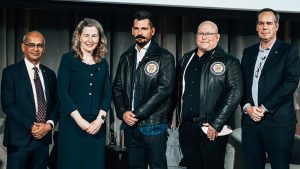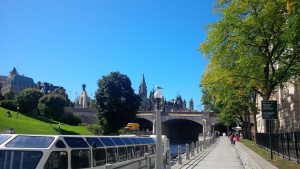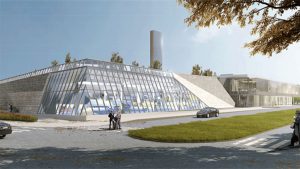The renewal of Canada’s Science and Technology Museum proceeds swiftly and on target to reopen in November 2017, the month of its 50th anniversary, says a museum spokesman.
"We’ve had some very creative, dedicated teams doing a lot of value engineering," to ensure the deadline and budget is met, says Fern Proulx, museum chief operating officer.
And it’s not the only build the museum has on the go.
Steps away on its property in an Ottawa suburb will rise a $156-million, 387,500-square-foot multi-storey controlled climate storage facility. The facility will house the museum’s extensive collection of artifacts that range in size from large locomotives to 1930s radio vacuum tubes, ice boxes, televisions, motorcycles, bicycles and canoes.
"It is a complex building based on the mechanical sensitivity for materials, the UV light controls — and the weight loads," Proulx says.
The storage building has been in the chief operating officer’s sights since 2002. Currently, three Ottawa warehouses shelter the bulk of the museum’s collection. Proulx says by owning its own storage building the museum will save money and possess a purpose-built facility.
Toronto-based Diamond Schmitt takes on the role of prime consultant and Pomerleau Inc. is construction manager on the project.
"This would be phase one of the collection reserve and we have room for expansion," Proulx says.
Planning has begun and museum staff has set the fall of 2018 as the goal of completion for the storage facility.
Right now, however, the renewal of the museum is the priority.
The 2014 discovery of mould in the facility, which was once a bakery distribution centre, precipitated the decision to undertake the work.
The former federal government granted $80.5 million to empty the museum of its artifacts and store them, build new exhibits and address the building’s many problems. These include the need for a new roof, HVAC system and facade as well as upgrades to meet current building codes for fire and seismic resistance.
"It’s more than a renovation," says Proulx. "It’s going to be a brand new museum once we reopen."
Pomerleau is the project’s construction manager and verTerra the project manager. NORR handled the project’s architecture and engineering and is its prime consultant.
The decision to rebuild rather than create from scratch had to do with time constraints and location, says Proulx.
The government owns the 30-acre site and the suburban location suits the family-oriented demographic who are the museum’s most frequent visitors, Proulx says. The site is also large, with ample room for other buildings to create a highly-integrated, interactive science and innovation campus in the city’s east end.
Moreover, the quickest path to reopening as soon as possible lay in using the same foundation and structural steel.
"Not being open in 2017 at the 150th anniversary of Canada, it was something that really irked me," Proulx says.
Planning began in November 2014. Construction followed in August 2015.
The refurbishment adds 8,000 square feet to the existing 80,000 square feet of exhibition space and is achieved by a more efficient allocation of space. The museum’s existing footprint remains the same. Floors, once uneven, have been levelled. The redesigned entrance includes a large LED screen and adds more natural light. The new temporary exhibition hall comes with the mechanical and environmental systems needed to display fragile artifacts.
One discovery made during the project was an inadequate electrical load in the building for a museum space, especially for running interactive exhibits.
"We were running at about 30 per cent of what a normal museum should be," Proulx says. The system upgrade "was a major change order into the original budget."
To meet the tight timeline, the project’s builders adopted several timesaving measures. For instance, original plans to upgrade the building’s seismic resistance had called for breaking up the cinder blocks on the building’s exterior and adding rebar. Builders instead removed the walls and added pre-fabricated sandwich boards to speed the process. They reached their goals for seismic resistance by improving the building’s anchoring to the foundation and reinforcing crossbeams and connection plates.
In an email, museum media relations spokesperson Caroline Boutin notes the prefabricated walls offered better seismic protection than the former cinder blocks with the added benefit of creating a greater R-value.
"The old cinder block walls were not insulated," she writes.
Once the building is complete in early April, exhibition teams take over for six months to install the new exhibits.
"In order for us to be able to do this and mitigate risk, what we’ve done is to boil the project down into two components, the container and the contents," Proulx explains. "And what we’re doing is building the exhibitions in parallel, so we have five different exhibition fabrication firms from Toronto, Montreal, Ottawa and Ohio who are actually doing design concept and testing in their labs, doing prefabrication in their labs."
Logistics surrounding the new exhibition designs and implementations complicate the project. Exhibit designers have to make sure there are no structural components such as steel posts or HVAC systems cutting through the exhibition space.
"That co-ordination is rather unique and something we’ve done really well," says Proulx.
When complete, the new facility will offer more digital and interactive experiences, room for more artifacts on the floor and even, in partnership with the University of Ottawa’s early childhood education program, a living lab to explore how children are learning and study learning prototypes.
"We’re extremely excited about this (museum) making a difference in Canada," says Proulx. "Science culture history is super exciting for us at this point and I can’t wait to see it open."








Recent Comments
comments for this post are closed